在上一篇文章中,我们已经介绍了如何使用REST接口来在Elasticsearch中创建index,文档以及对它们的操作。在今天的文章里,我们来介绍如何利用Elasticsearch来搜索我们的数据。Elasticsearch是近实时的搜索。我们还是接着我们上次的练习“开始使用Elasticsearch (1)”
搜索所有的文档
我们可以使用如下的命令来搜索到所有的文档:
GET /_search
在这里我们没有指定任何index,我们将搜索在该cluster下的所有的index。目前默认的返回个数是10个,除非我们设定size:
GET /_search?size=20
如果我们只想搜索我们特定的index,比如twitter,我们可以这么做:
GET twitter/_search
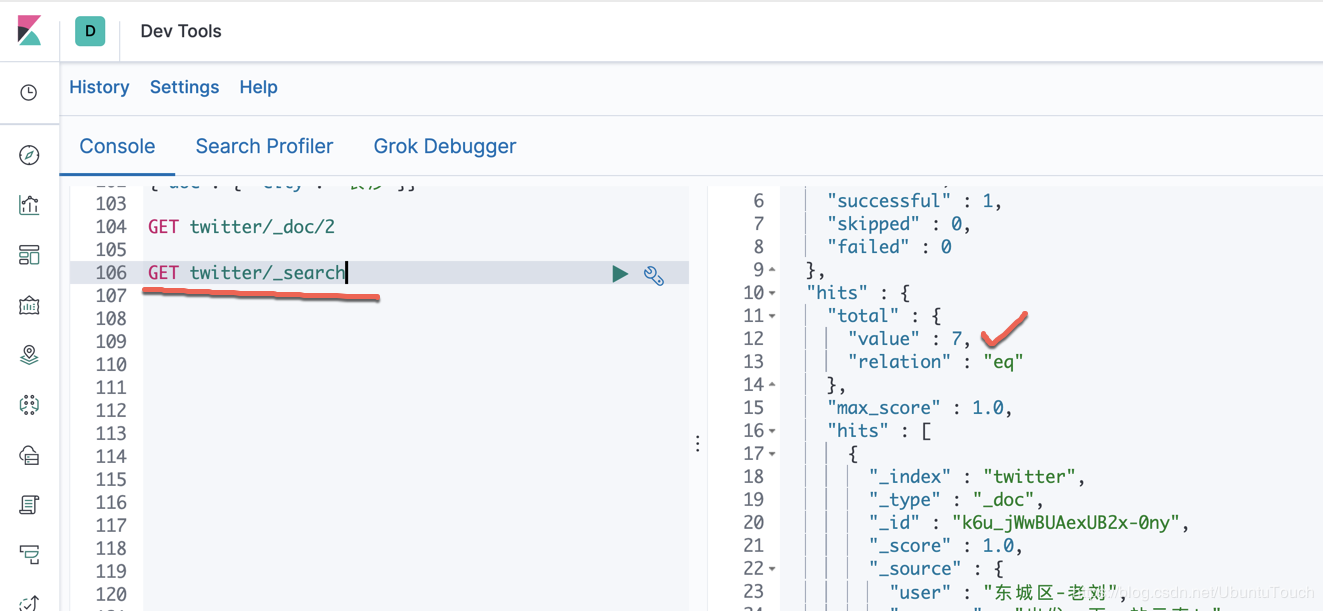
从上面我们可以看出来,在twitter index里我们有7个文档。在上面的hits数组里,我们可以看到所有的结果。在默认的情况下,我们可以得到10个结果。我们可以通过设置size参数得到我们想要的个数。同时,我们可以也配合from来进行page。
GET twitter/_search?size=2&from=2
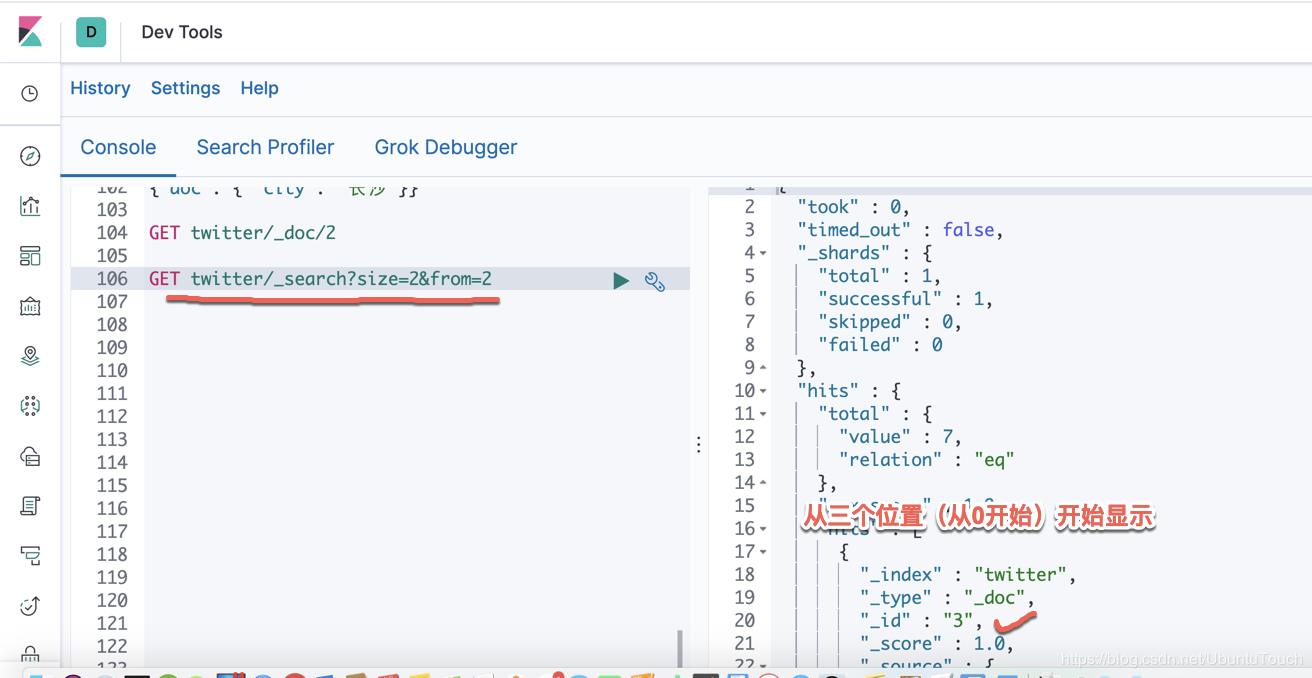
并且只要两个文档显示。我们可以通过这个方法让我们的文档进行分页显示。
上面的查询类似于DSL查询的如下语句:
GET twitter/_search
{
"size": 2,
"from": 2,
"query": {
"match_all": {}
}
}
修改settings
我们可以通过如下的接口来获得一个index的settings
GET twitter/_settings
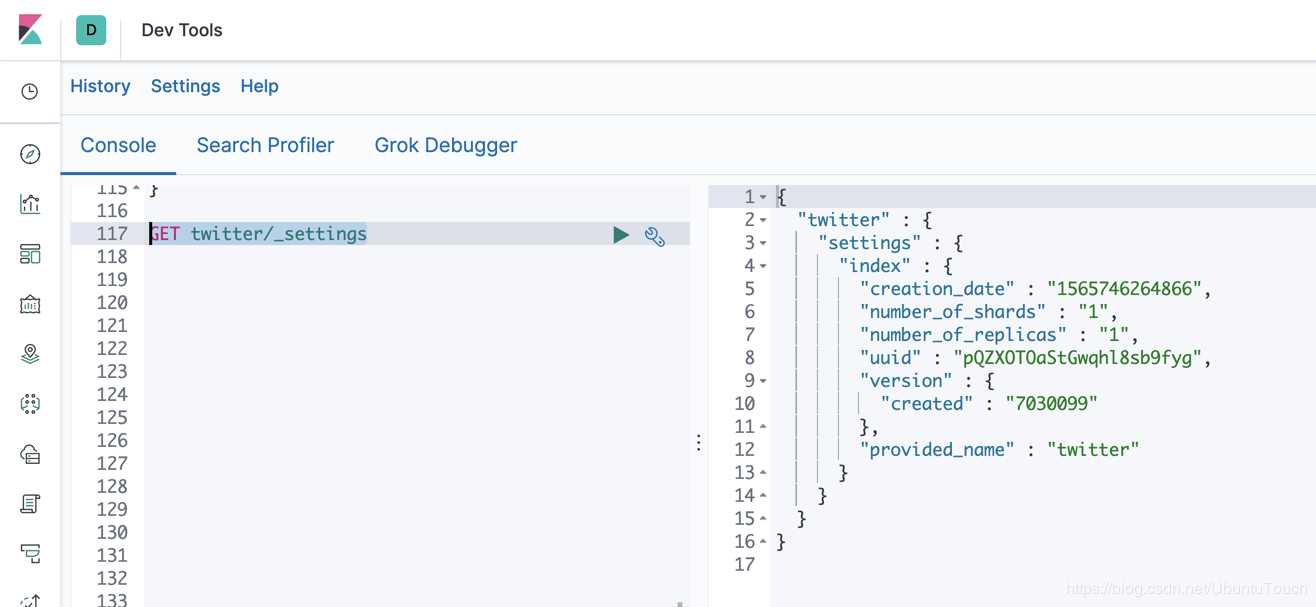
从这里我们可以看到我们的twitter index有多少个shards及多少个replicas。我们也可以通过如下的接口来设置:
PUT twitter
{
"settings": {
"number_of_shards": 1,
"number_of_replicas": 1
}
}
一旦我们把number_of_shards定下来了,我们就不可以修改了,除非把index删除,并重新index它。这是因为每个文档存储到哪一个shard是和number_of_shards这个数值有关的。一旦这个数值发生改变,那么之后寻找那个文档所在的shard就会不准确。
修改index的mapping
Elasticsearch号称是schemaless,在实际所得应用中,每一个index都有一个相应的mapping。这个mapping在我们生产第一个文档时已经生产。它是对每个输入的字段进行自动的识别从而判断它们的数据类型。我们可以这么理解schemaless:
- 不需要事先定义一个相应的mapping才可以生产文档。字段类型是动态进行识别的。这和传统的数据库是不一样的
- 如果有动态加入新的字段,mapping也可以自动进行调整并识别新加入的字段 自动识别字段有一个问题,那就是有的字段可能识别并不精确,比如对于我们例子中的位置信息。那么我们需要对这个字段进行修改。
我们可以通过如下的命令来查询目前的index的mapping:
GET twitter/_mapping
它显示的数据如下:
{
"twitter" : {
"mappings" : {
"properties" : {
"address" : {
"type" : "text",
"fields" : {
"keyword" : {
"type" : "keyword",
"ignore_above" : 256
}
}
},
"age" : {
"type" : "long"
},
"city" : {
"type" : "text",
"fields" : {
"keyword" : {
"type" : "keyword",
"ignore_above" : 256
}
}
},
"country" : {
"type" : "text",
"fields" : {
"keyword" : {
"type" : "keyword",
"ignore_above" : 256
}
}
},
"location" : {
"properties" : {
"lat" : {
"type" : "text",
"fields" : {
"keyword" : {
"type" : "keyword",
"ignore_above" : 256
}
}
},
"lon" : {
"type" : "text",
"fields" : {
"keyword" : {
"type" : "keyword",
"ignore_above" : 256
}
}
}
}
},
"message" : {
"type" : "text",
"fields" : {
"keyword" : {
"type" : "keyword",
"ignore_above" : 256
}
}
},
"province" : {
"type" : "text",
"fields" : {
"keyword" : {
"type" : "keyword",
"ignore_above" : 256
}
}
},
"uid" : {
"type" : "long"
},
"user" : {
"type" : "text",
"fields" : {
"keyword" : {
"type" : "keyword",
"ignore_above" : 256
}
}
}
}
}
}
}
从上面的显示中可以看出来location里的经纬度是一个multi-field的类型。
"location" : {
"properties" : {
"lat" : {
"type" : "text",
"fields" : {
"keyword" : {
"type" : "keyword",
"ignore_above" : 256
}
}
},
"lon" : {
"type" : "text",
"fields" : {
"keyword" : {
"type" : "keyword",
"ignore_above" : 256
}
}
}
}
}
这个显然不是我们所需的。正确的类型应该是:geo_point。我们重新修正我们的mapping。
注意:我们不能为已经建立好的index动态修改mapping。这是因为一旦修改,那么之前建立的索引就变成不能搜索的了。一种办法是reindex从而重新建立我们的索引。如果在之前的mapping加入新的字段,那么我们可以不用重新建立索引。
为了能够正确地创建我们的mapping,我们必须先把之前的twitter索引删除掉,并同时使用settings来创建这个index。具体的步骤如下:
DELETE twitter
PUT twitter
{
"settings": {
"number_of_shards": 1,
"number_of_replicas": 1
}
}
PUT twitter/_mapping
{
"properties": {
"address": {
"type": "text",
"fields": {
"keyword": {
"type": "keyword",
"ignore_above": 256
}
}
},
"age": {
"type": "long"
},
"city": {
"type": "text",
"fields": {
"keyword": {
"type": "keyword",
"ignore_above": 256
}
}
},
"country": {
"type": "text",
"fields": {
"keyword": {
"type": "keyword",
"ignore_above": 256
}
}
},
"location": {
"type": "geo_point"
},
"message": {
"type": "text",
"fields": {
"keyword": {
"type": "keyword",
"ignore_above": 256
}
}
},
"province": {
"type": "text",
"fields": {
"keyword": {
"type": "keyword",
"ignore_above": 256
}
}
},
"uid": {
"type": "long"
},
"user": {
"type": "text",
"fields": {
"keyword": {
"type": "keyword",
"ignore_above": 256
}
}
}
}
}
重新查看我们的mapping:
GET twitter/_mapping
我们可以看到我们已经创建好了新的mapping。我们再次运行之前我们的bulk接口,并把我们所需要的数据导入到twitter索引中。
POST _bulk
{ "index" : { "_index" : "twitter", "_id": 1} }
{"user":"双榆树-张三","message":"今儿天气不错啊,出去转转去","uid":2,"age":20,"city":"北京","province":"北京","country":"中国","address":"中国北京市海淀区","location":{"lat":"39.970718","lon":"116.325747"}}
{ "index" : { "_index" : "twitter", "_id": 2 }}
{"user":"东城区-老刘","message":"出发,下一站云南!","uid":3,"age":30,"city":"北京","province":"北京","country":"中国","address":"中国北京市东城区台基厂三条3号","location":{"lat":"39.904313","lon":"116.412754"}}
{ "index" : { "_index" : "twitter", "_id": 3} }
{"user":"东城区-李四","message":"happy birthday!","uid":4,"age":30,"city":"北京","province":"北京","country":"中国","address":"中国北京市东城区","location":{"lat":"39.893801","lon":"116.408986"}}
{ "index" : { "_index" : "twitter", "_id": 4} }
{"user":"朝阳区-老贾","message":"123,gogogo","uid":5,"age":35,"city":"北京","province":"北京","country":"中国","address":"中国北京市朝阳区建国门","location":{"lat":"39.718256","lon":"116.367910"}}
{ "index" : { "_index" : "twitter", "_id": 5} }
{"user":"朝阳区-老王","message":"Happy BirthDay My Friend!","uid":6,"age":50,"city":"北京","province":"北京","country":"中国","address":"中国北京市朝阳区国贸","location":{"lat":"39.918256","lon":"116.467910"}}
{ "index" : { "_index" : "twitter", "_id": 6} }
{"user":"虹桥-老吴","message":"好友来了都今天我生日,好友来了,什么 birthday happy 就成!","uid":7,"age":90,"city":"上海","province":"上海","country":"中国","address":"中国上海市闵行区","location":{"lat":"31.175927","lon":"121.383328"}}
至此,我们已经完整地建立了我们所需要的索引。在下面,我们开始使用DSL(Domain Specifc Lanaguage)来帮我们进行查询。
查询数据
在这个章节里,我们来展示一下从我们的ES索引中查询我们所想要的数据。
查询所有在北京的用户:
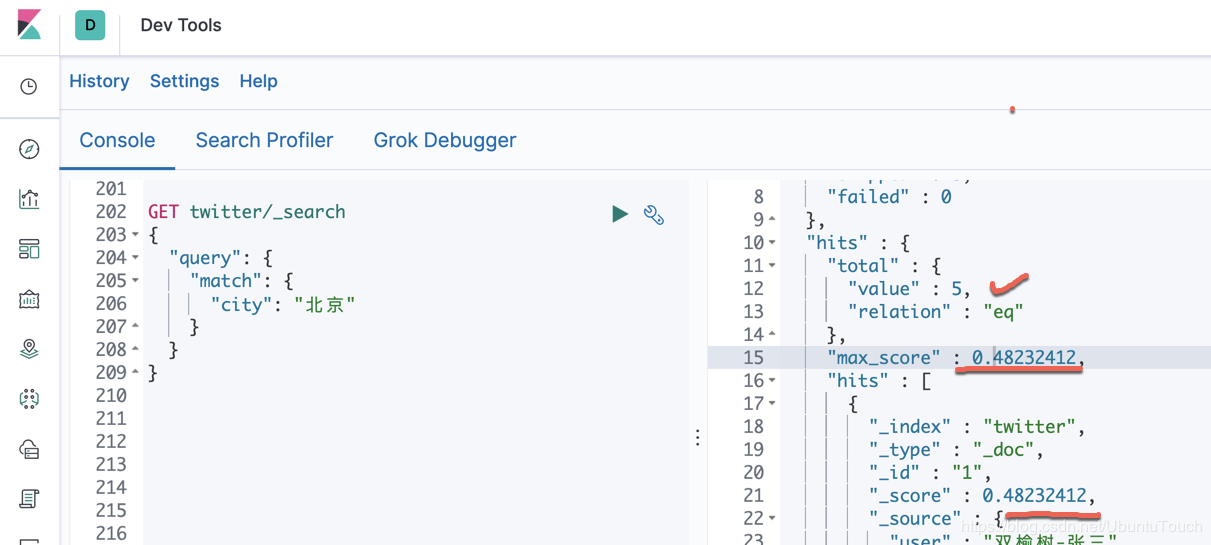
从我们查询的结果来看,我们可以看到有5个用户是来自北京的,而且查询出来的结果是按照关联(relavance)来进行排序的。如果我们不需要这个score,我们可以选择filter来完成。
GET twitter/_search
{
"query": {
"bool": {
"filter": {
"term": {
"city.keyword": "北京"
}
}
}
}
}
这里我们使用了filter来过滤我们的搜索,显示的结果如下:
{
"took" : 0,
"timed_out" : false,
"_shards" : {
"total" : 1,
"successful" : 1,
"skipped" : 0,
"failed" : 0
},
"hits" : {
"total" : {
"value" : 5,
"relation" : "eq"
},
"max_score" : 0.0,
"hits" : [
{
"_index" : "twitter",
"_type" : "_doc",
"_id" : "1",
"_score" : 0.0,
"_source" : {
"user" : "双榆树-张三",
"message" : "今儿天气不错啊,出去转转去",
"uid" : 2,
"age" : 20,
"city" : "北京",
"province" : "北京",
"country" : "中国",
"address" : "中国北京市海淀区",
"location" : {
"lat" : "39.970718",
"lon" : "116.325747"
}
}
},
...
}
从返回的结果来看,_score项为0。对于这种搜索,只要yes或no。我们并不关心它们是的相关性。在这里我们使用了city.keyword。对于一些刚接触Elasticsearch的人来说,这个可能比较陌生。正确的理解是city在我们的mapping中是一个multi-field项。它既是text也是keyword类型。对于一个keyword类型的项来说,这个项里面的所有字符都被当做一个字符串。它们在建立文档时,不需要进行index。所以在我们的filter中,我们是使用了term来完成这个查询。
我们也可以使用如下的办法达到同样的效果:
GET twitter/_search
{
"query": {
"constant_score": {
"filter": {
"term": {
"city": {
"value": "北京"
}
}
}
}
}
}
复合查询(compound query)
什么是复合查询呢?如果说上面的查询是leaf查询的话,那么复合查询可以把很多个leaf查询组合起来从而形成更为复杂的查询。它一般的格式是:
POST _search
{
"query": {
"bool" : {
"must" : {
"term" : { "user" : "kimchy" }
},
"filter": {
"term" : { "tag" : "tech" }
},
"must_not" : {
"range" : {
"age" : { "gte" : 10, "lte" : 20 }
}
},
"should" : [
{ "term" : { "tag" : "wow" } },
{ "term" : { "tag" : "elasticsearch" } }
],
"minimum_should_match" : 1,
"boost" : 1.0
}
}
}
从上面我们可以看出,它是由bool下面的must, must_not, should及filter共同来组成的。针对我们的例子,
GET twitter/_search
{
"query": {
"bool": {
"must": [
{
"match": {
"city": "北京"
}
},
{
"match": {
"age": "30"
}
}
]
}
}
}
这个查询的是必须是 北京城市的,并且年刚好是30岁的。
{
"took" : 1,
"timed_out" : false,
"_shards" : {
"total" : 1,
"successful" : 1,
"skipped" : 0,
"failed" : 0
},
"hits" : {
"total" : {
"value" : 2,
"relation" : "eq"
},
"max_score" : 1.4823241,
"hits" : [
{
"_index" : "twitter",
"_type" : "_doc",
"_id" : "2",
"_score" : 1.4823241,
"_source" : {
"user" : "东城区-老刘",
"message" : "出发,下一站云南!",
"uid" : 3,
"age" : 30,
"city" : "北京",
"province" : "北京",
"country" : "中国",
"address" : "中国北京市东城区台基厂三条3号",
"location" : {
"lat" : "39.904313",
"lon" : "116.412754"
}
}
},
{
"_index" : "twitter",
"_type" : "_doc",
"_id" : "3",
"_score" : 1.4823241,
"_source" : {
"user" : "东城区-李四",
"message" : "happy birthday!",
"uid" : 4,
"age" : 30,
"city" : "北京",
"province" : "北京",
"country" : "中国",
"address" : "中国北京市东城区",
"location" : {
"lat" : "39.893801",
"lon" : "116.408986"
}
}
}
]
}
}
如果我们想知道为什么得出来这样的结果,我们可以在搜索的指令中加入"explained" : true。
GET twitter/_search
{
"query": {
"bool": {
"must": [
{
"match": {
"city": "北京"
}
},
{
"match": {
"age": "30"
}
}
]
}
},
"explain": true
}
这样在我们的显示的结果中,可以看到一些一些解释:
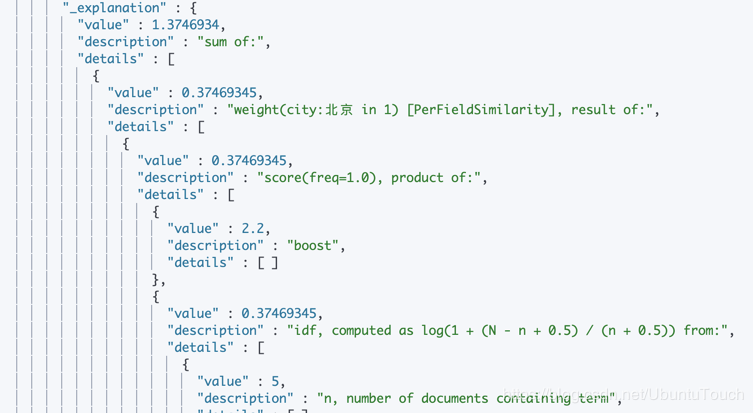
我们的显示结果有2个。同样,我们可以把一些满足条件的排出在外,我们可以使用must_not。
GET twitter/_search
{
"query": {
"bool": {
"must_not": [
{
"match": {
"city": "北京"
}
}
]
}
}
}
我们想寻找不在北京的所有的文档:
{
"took" : 0,
"timed_out" : false,
"_shards" : {
"total" : 1,
"successful" : 1,
"skipped" : 0,
"failed" : 0
},
"hits" : {
"total" : {
"value" : 1,
"relation" : "eq"
},
"max_score" : 0.0,
"hits" : [
{
"_index" : "twitter",
"_type" : "_doc",
"_id" : "6",
"_score" : 0.0,
"_source" : {
"user" : "虹桥-老吴",
"message" : "好友来了都今天我生日,好友来了,什么 birthday happy 就成!",
"uid" : 7,
"age" : 90,
"city" : "上海",
"province" : "上海",
"country" : "中国",
"address" : "中国上海市闵行区",
"location" : {
"lat" : "31.175927",
"lon" : "121.383328"
}
}
}
]
}
}
我们显示的文档只有一个。他来自上海,其余的都北京的。
接下来,我们来尝试一下should。它表述“或”的意思,也就是有就更好,没有就算了。比如:
GET twitter/_search
{
"query": {
"bool": {
"must": [
{
"match": {
"age": "30"
}
}
],
"should": [
{
"match_phrase": {
"message": "Happy birthday"
}
}
]
}
}
}
这个搜寻的意思是,age必须是30岁,但是如果文档里含有“Hanppy birthday”,相关性会更高,那么搜索得到的结果会排在前面:
{
"took" : 8,
"timed_out" : false,
"_shards" : {
"total" : 1,
"successful" : 1,
"skipped" : 0,
"failed" : 0
},
"hits" : {
"total" : {
"value" : 2,
"relation" : "eq"
},
"max_score" : 2.641438,
"hits" : [
{
"_index" : "twitter",
"_type" : "_doc",
"_id" : "3",
"_score" : 2.641438,
"_source" : {
"user" : "东城区-李四",
"message" : "happy birthday!",
"uid" : 4,
"age" : 30,
"city" : "北京",
"province" : "北京",
"country" : "中国",
"address" : "中国北京市东城区",
"location" : {
"lat" : "39.893801",
"lon" : "116.408986"
}
}
},
{
"_index" : "twitter",
"_type" : "_doc",
"_id" : "2",
"_score" : 1.0,
"_source" : {
"user" : "东城区-老刘",
"message" : "出发,下一站云南!",
"uid" : 3,
"age" : 30,
"city" : "北京",
"province" : "北京",
"country" : "中国",
"address" : "中国北京市东城区台基厂三条3号",
"location" : {
"lat" : "39.904313",
"lon" : "116.412754"
}
}
}
]
}
}
在上面的结果中,我们可以看到:同样是年龄30岁的两个文档,第一个文档由于含有“Happy birthday”这个字符串在message里,所以它的结果是排在前面的,相关性更高。我们可以从它的_score中可以看出来。第二个文档里age是30,但是它的message里没有“Happy birthday”字样,但是它的结果还是有显示,只是得分比较低一些。
位置查询
Elasticsearch最厉害的是位置查询。这在很多的关系数据库里并没有。我们举一个简单的例子:
GET twitter/_search
{
"query": {
"bool": {
"must": [
{
"match": {
"address": "北京"
}
}
]
}
},
"post_filter": {
"geo_distance": {
"distance": "3km",
"location": {
"lat": 39.920086,
"lon": 116.454182
}
}
}
}
在这里,我们查找在地址栏里有“北京”,并且在以位置(116.454182, 39.920086)为中心的3公里以内的所有文档。
{
"took" : 58,
"timed_out" : false,
"_shards" : {
"total" : 1,
"successful" : 1,
"skipped" : 0,
"failed" : 0
},
"hits" : {
"total" : {
"value" : 1,
"relation" : "eq"
},
"max_score" : 0.48232412,
"hits" : [
{
"_index" : "twitter",
"_type" : "_doc",
"_id" : "5",
"_score" : 0.48232412,
"_source" : {
"user" : "朝阳区-老王",
"message" : "Happy BirthDay My Friend!",
"uid" : 6,
"age" : 50,
"city" : "北京",
"province" : "北京",
"country" : "中国",
"address" : "中国北京市朝阳区国贸",
"location" : {
"lat" : "39.918256",
"lon" : "116.467910"
}
}
}
]
}
}
在我们的查询结果中只有一个文档满足要求。
下面,我们找出在5公里以内的所有位置信息,并按照远近大小进行排序:
GET twitter/_search
{
"query": {
"bool": {
"must": [
{
"match": {
"address": "北京"
}
}
]
}
},
"post_filter": {
"geo_distance": {
"distance": "5km",
"location": {
"lat": 39.920086,
"lon": 116.454182
}
}
},
"sort": [
{
"_geo_distance": {
"location": "39.920086,116.454182",
"order": "asc",
"unit": "km"
}
}
]
}
在这里,我们看到了使用sort来对我们的搜索的结果进行排序。按照升序排列。
{
"took" : 5,
"timed_out" : false,
"_shards" : {
"total" : 1,
"successful" : 1,
"skipped" : 0,
"failed" : 0
},
"hits" : {
"total" : {
"value" : 3,
"relation" : "eq"
},
"max_score" : null,
"hits" : [
{
"_index" : "twitter",
"_type" : "_doc",
"_id" : "5",
"_score" : null,
"_source" : {
"user" : "朝阳区-老王",
"message" : "Happy BirthDay My Friend!",
"uid" : 6,
"age" : 50,
"city" : "北京",
"province" : "北京",
"country" : "中国",
"address" : "中国北京市朝阳区国贸",
"location" : {
"lat" : "39.918256",
"lon" : "116.467910"
}
},
"sort" : [
1.1882901656104885
]
},
{
"_index" : "twitter",
"_type" : "_doc",
"_id" : "2",
"_score" : null,
"_source" : {
"user" : "东城区-老刘",
"message" : "出发,下一站云南!",
"uid" : 3,
"age" : 30,
"city" : "北京",
"province" : "北京",
"country" : "中国",
"address" : "中国北京市东城区台基厂三条3号",
"location" : {
"lat" : "39.904313",
"lon" : "116.412754"
}
},
"sort" : [
3.9447355972239952
]
},
{
"_index" : "twitter",
"_type" : "_doc",
"_id" : "3",
"_score" : null,
"_source" : {
"user" : "东城区-李四",
"message" : "happy birthday!",
"uid" : 4,
"age" : 30,
"city" : "北京",
"province" : "北京",
"country" : "中国",
"address" : "中国北京市东城区",
"location" : {
"lat" : "39.893801",
"lon" : "116.408986"
}
},
"sort" : [
4.837769064666224
]
}
]
}
}
我们可以看到有三个显示的结果。在sort里我们可以看到距离是越来越大啊。
范围查询
在ES中,我们也可以进行范围查询。我们可以根据设定的范围来对数据进行查询:
GET twitter/_search
{
"query": {
"range": {
"age": {
"gte": 30,
"lte": 40
}
}
}
}
在这里,我们查询年龄介于30到40岁的文档:
{
"took" : 0,
"timed_out" : false,
"_shards" : {
"total" : 1,
"successful" : 1,
"skipped" : 0,
"failed" : 0
},
"hits" : {
"total" : {
"value" : 3,
"relation" : "eq"
},
"max_score" : 1.0,
"hits" : [
{
"_index" : "twitter",
"_type" : "_doc",
"_id" : "2",
"_score" : 1.0,
"_source" : {
"user" : "东城区-老刘",
"message" : "出发,下一站云南!",
"uid" : 3,
"age" : 30,
"city" : "北京",
"province" : "北京",
"country" : "中国",
"address" : "中国北京市东城区台基厂三条3号",
"location" : {
"lat" : "39.904313",
"lon" : "116.412754"
}
}
},
{
"_index" : "twitter",
"_type" : "_doc",
"_id" : "3",
"_score" : 1.0,
"_source" : {
"user" : "东城区-李四",
"message" : "happy birthday!",
"uid" : 4,
"age" : 30,
"city" : "北京",
"province" : "北京",
"country" : "中国",
"address" : "中国北京市东城区",
"location" : {
"lat" : "39.893801",
"lon" : "116.408986"
}
}
},
{
"_index" : "twitter",
"_type" : "_doc",
"_id" : "4",
"_score" : 1.0,
"_source" : {
"user" : "朝阳区-老贾",
"message" : "123,gogogo",
"uid" : 5,
"age" : 35,
"city" : "北京",
"province" : "北京",
"country" : "中国",
"address" : "中国北京市朝阳区建国门",
"location" : {
"lat" : "39.718256",
"lon" : "116.367910"
}
}
}
]
}
}
如上所示,我们找到了3个匹配的文档。同样地,我们也可以对它们进行排序:
GET twitter/_search
{
"query": {
"range": {
"age": {
"gte": 30,
"lte": 40
}
}
},"sort": [
{
"age": {
"order": "desc"
}
}
]
}
我们对整个搜索的结果按照降序进行排序。
Exists 查询
我们可以通过exists来查询一个字段是否存在。比如我们再增加一个文档:
PUT twitter/_doc/20
{
"user" : "王二",
"message" : "今儿天气不错啊,出去转转去",
"uid" : 20,
"age" : 40,
"province" : "北京",
"country" : "中国",
"address" : "中国北京市海淀区",
"location" : {
"lat" : "39.970718",
"lon" : "116.325747"
}
}
在这个文档里,我们的city这一个字段是不存在的,那么一下的这个搜索将不会返回上面的这个搜索。
GET twitter/_search
{
"query": {
"exists": {
"field": "city"
}
}
}
如果文档里只要city这个字段不为空,那么就会被返回。反之,如果一个文档里city这个字段是空的,那么就不会返回。
匹配短语
我们可以通过如下的方法来查找happy birthday。
GET twitter/_search
{
"query": {
"match": {
"message": "happy birthday"
}
}
}
展示的结果:
{
"took" : 0,
"timed_out" : false,
"_shards" : {
"total" : 1,
"successful" : 1,
"skipped" : 0,
"failed" : 0
},
"hits" : {
"total" : {
"value" : 3,
"relation" : "eq"
},
"max_score" : 1.9936417,
"hits" : [
{
"_index" : "twitter",
"_type" : "_doc",
"_id" : "3",
"_score" : 1.9936417,
"_source" : {
"user" : "东城区-李四",
"message" : "happy birthday!",
"uid" : 4,
"age" : 30,
"city" : "北京",
"province" : "北京",
"country" : "中国",
"address" : "中国北京市东城区",
"location" : {
"lat" : "39.893801",
"lon" : "116.408986"
}
}
},
{
"_index" : "twitter",
"_type" : "_doc",
"_id" : "5",
"_score" : 1.733287,
"_source" : {
"user" : "朝阳区-老王",
"message" : "Happy BirthDay My Friend!",
"uid" : 6,
"age" : 50,
"city" : "北京",
"province" : "北京",
"country" : "中国",
"address" : "中国北京市朝阳区国贸",
"location" : {
"lat" : "39.918256",
"lon" : "116.467910"
}
}
},
{
"_index" : "twitter",
"_type" : "_doc",
"_id" : "6",
"_score" : 0.84768087,
"_source" : {
"user" : "虹桥-老吴",
"message" : "好友来了都今天我生日,好友来了,什么 birthday happy 就成!",
"uid" : 7,
"age" : 90,
"city" : "上海",
"province" : "上海",
"country" : "中国",
"address" : "中国上海市闵行区",
"location" : {
"lat" : "31.175927",
"lon" : "121.383328"
}
}
}
]
}
}
在默认的情况下,这个匹配是“或”的关系,也就是找到文档里含有“Happy"或者“birthday”的文档。如果我们新增加一个文档:
PUT twitter/_doc/8
{
"user": "朝阳区-老王",
"message": "Happy",
"uid": 6,
"age": 50,
"city": "北京",
"province": "北京",
"country": "中国",
"address": "中国北京市朝阳区国贸",
"location": {
"lat": "39.918256",
"lon": "116.467910"
}
}
那么我们重新进行搜索,我们可以看到这个新增加的id为8的也会在搜索出的结果之列,虽然它只含有“Happy"在message里。
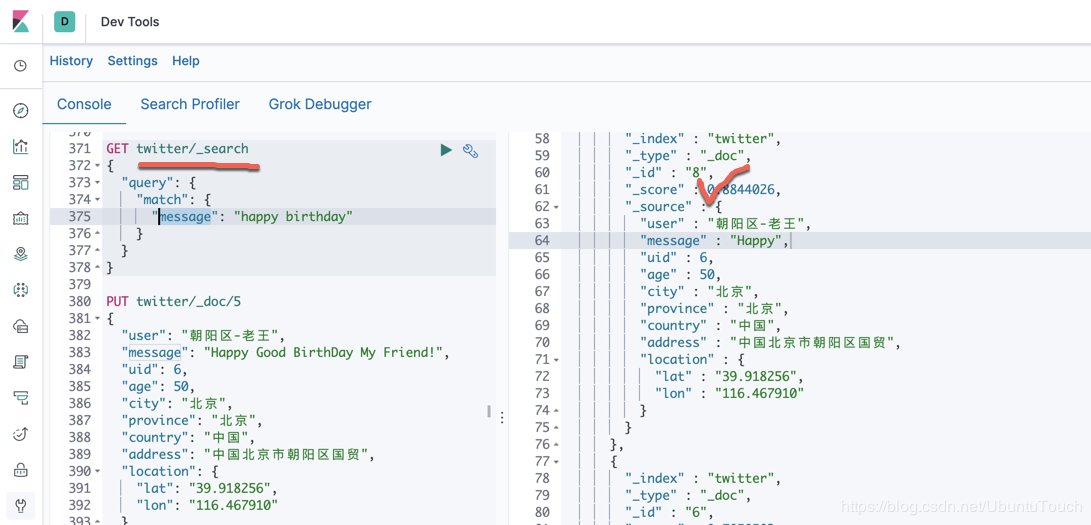
如果我们想得到“与”的关系,我们可以采用如下的办法:
GET twitter/_search
{
"query": {
"match": {
"message": {
"query": "happy birthday",
"operator": "and"
}
}
}
}
经过这样的修改,我们再也看不见那个id为8的文档了,这是因为我们必须在message中同时匹配“happy”及“birthday”这两个词。
我们还有一种方法,那就是:
GET twitter/_search
{
"query": {
"match": {
"message": {
"query": "happy birthday",
"minimum_should_match": 2
}
}
}
}
在这里,我们采用了“minimum_should_match”来表面至少有2个是匹配的才可以。
我们可以看到在搜索到的结果中,无论我们搜索的是大小写字母,在搜索的时候,我们都可以匹配到,并且在message中,happy birthday这两个词的先后顺序也不是很重要。比如,我们把id为5的文档更改为:
PUT twitter/_doc/5
{
"user": "朝阳区-老王",
"message": "BirthDay My Friend Happy !",
"uid": 6,
"age": 50,
"city": "北京",
"province": "北京",
"country": "中国",
"address": "中国北京市朝阳区国贸",
"location": {
"lat": "39.918256",
"lon": "116.467910"
}
}
在这里,我们有意识地把BirthDay弄到Happy的前面。我们再次使用上面的查询看看是否找到id为5的文档。
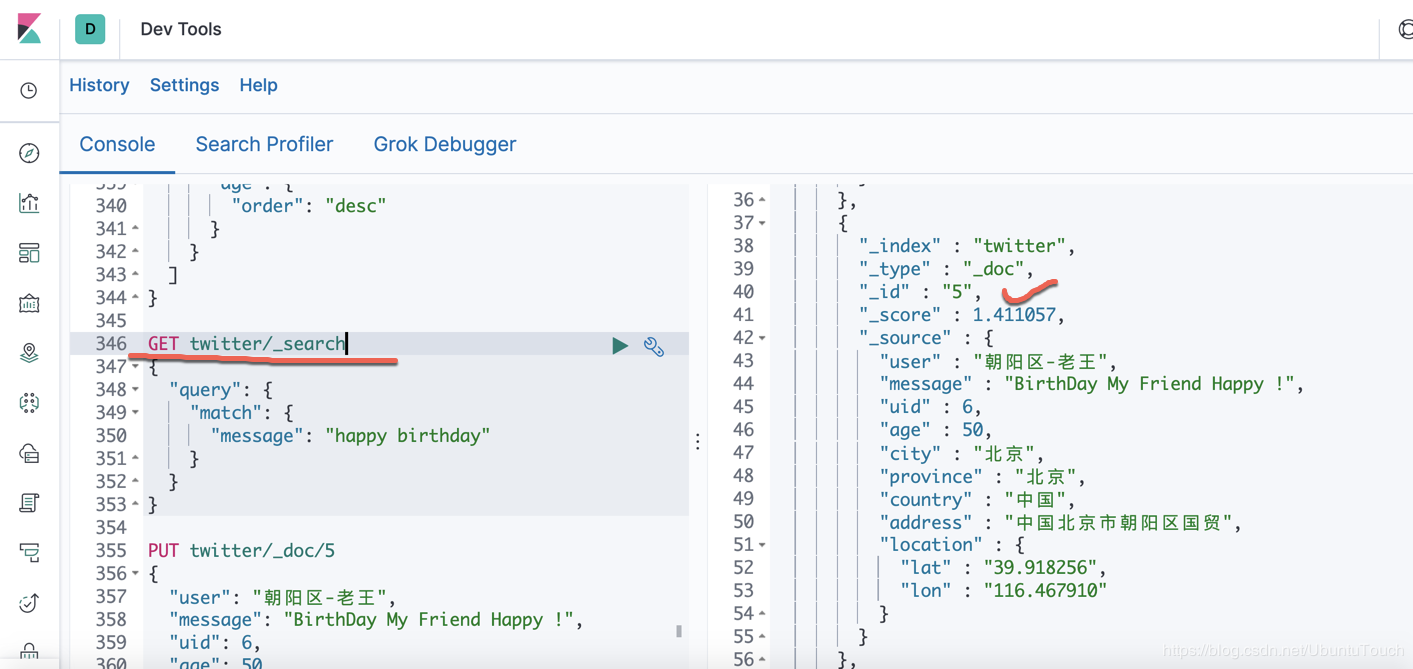
显然,match查询时时不用分先后顺序的。我们下面使用match_phrase来看看。
GET twitter/_search
{
"query": {
"match_phrase": {
"message": "Happy birthday"
}
},
"highlight": {
"fields": {
"message": {}
}
}
}
在这里,我们可以看到我们使用了match_phrase。它要求Happy必须是在birthday的前面。下面是搜寻的结果:
{
"took" : 1,
"timed_out" : false,
"_shards" : {
"total" : 1,
"successful" : 1,
"skipped" : 0,
"failed" : 0
},
"hits" : {
"total" : {
"value" : 1,
"relation" : "eq"
},
"max_score" : 1.6363969,
"hits" : [
{
"_index" : "twitter",
"_type" : "_doc",
"_id" : "3",
"_score" : 1.6363969,
"_source" : {
"user" : "东城区-李四",
"message" : "happy birthday!",
"uid" : 4,
"age" : 30,
"city" : "北京",
"province" : "北京",
"country" : "中国",
"address" : "中国北京市东城区",
"location" : {
"lat" : "39.893801",
"lon" : "116.408986"
}
},
"highlight" : {
"message" : [
"<em>happy</em> <em>birthday</em>!"
]
}
}
]
}
}
假如我们把我们之前的那个id为5的文档修改为:
PUT twitter/_doc/5
{
"user": "朝阳区-老王",
"message": "Happy Good BirthDay My Friend!",
"uid": 6,
"age": 50,
"city": "北京",
"province": "北京",
"country": "中国",
"address": "中国北京市朝阳区国贸",
"location": {
"lat": "39.918256",
"lon": "116.467910"
}
}
在这里,我们在Happy 和Birthday之前加入了一个Good。如果用我们之前的那个match_phrase是找不到这个文档的。为了能够找到上面这个修正的结果,我们可以使用:
GET twitter/_search
{
"query": {
"match_phrase": {
"message": {
"query": "Happy birthday",
"slop": 1
}
}
},
"highlight": {
"fields": {
"message": {}
}
}
}
注意:在这里,我们使用了slop为1,表面Happy和birthday之前是可以允许一个token的差别。
SQL查询
对于与很多已经习惯用RDMS数据库的工作人员,他们更喜欢使用SQL来进行查询。Elasticsearch也对SQL有支持:
GET /_sql?
{
"query": """
SELECT * FROM twitter
WHERE age = 30
"""
}
通过这个查询,我们可以找到所有在年龄等于30的用户。在个搜索中,我们使用了SQL语句。利用SQL端点我们可以很快地把我们的SQL知识转化为Elasticsearch的使用场景中来。我们可以通过如下的方法得到它对应的DSL语句:
GET /_sql/translate
{
"query": """
SELECT * FROM twitter
WHERE age = 30
"""
}
我们得到的结果是:
{
"size" : 1000,
"query" : {
"term" : {
"age" : {
"value" : 30,
"boost" : 1.0
}
}
},
"_source" : {
"includes" : [
"address",
"message",
"region",
"script.source",
"user"
],
"excludes" : [ ]
},
"docvalue_fields" : [
{
"field" : "age"
},
{
"field" : "city"
},
{
"field" : "country"
},
{
"field" : "location"
},
{
"field" : "province"
},
{
"field" : "script.params.value"
},
{
"field" : "uid"
}
],
"sort" : [
{
"_doc" : {
"order" : "asc"
}
}
]
}
Multi Search API
使用单个API请求执行几次搜索。这个API的好处是节省API的请求个数,把多个请求放到一个API中来实现。
为了说明问题的方便,我们可以多加一个叫做twitter1的index。它的内容如下:
POST _bulk
{"index":{"_index":"twitter1","_id":1}}
{"user":"张庆","message":"今儿天气不错啊,出去转转去","uid":2,"age":20,"city":"重庆","province":"重庆","country":"中国","address":"中国重庆地区","location":{"lat":"39.970718","lon":"116.325747"}}
这样在我们的Elasticsearch中就有两个索引了。我们可以做如下的_msearch。
GET twitter/_msearch
{"index":"twitter"}
{"query":{"match_all":{}},"from":0,"size":1}
{"index":"twitter"}
{"query":{"bool":{"filter":{"term":{"city.keyword":"北京"}}}}, "size":1}
{"index":"twitter1"}
{"query":{"match_all":{}}}
上面我们通过_msearch终点来实现在一个API请求中做多个查询,对多个index进行同时操作。显示结果为:
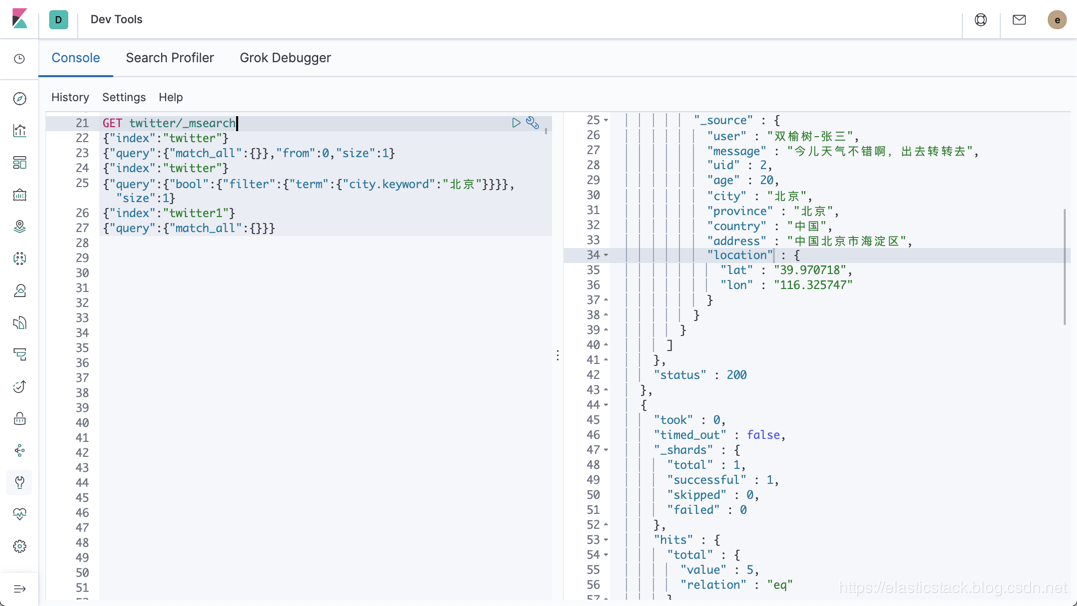
多个索引操作
在上面我们引入了另外一个索引twitter1。在实际的操作中,我们可以通过通配符,或者直接使用多个索引来进行搜索:
GET twitter*/_search
上面的操作是对所有的以twitter为开头的索引来进行搜索,显示的结果是在所有的twitter及twitter1中的文档:
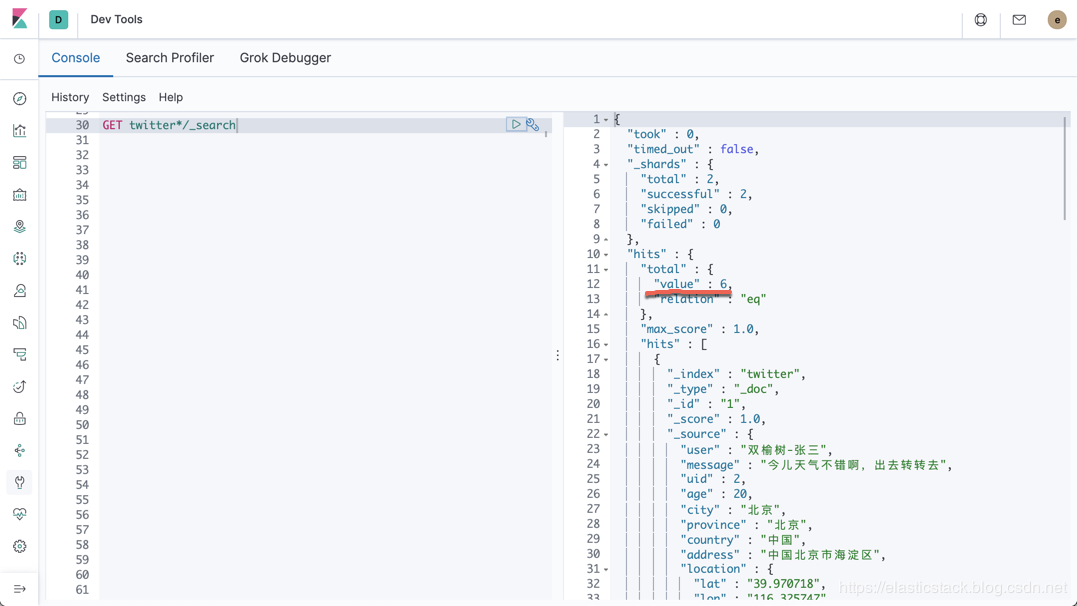
GET /twitter,twitter1/_search
也可以做同样的事。在写上面的查询的时候,在两个索引之间不能加入空格,比如:
GET /twitter, twitter1/_search
上面的查询并不能返回你所想要的结果。
总结 在今天的文章里,我们介绍了如何使用Elasticsearch所提供的DSL来对我们的index进行搜索。Elasticsearch为index提供了丰富的搜索方式。在这里就算是抛转引玉。在接下来的文章“开始使用Elasticsearch (3)”里我们来重点介绍一下聚合aggregation及analyzer。
如果你想了解更多关于Elastic Stack相关的知识,请参阅我们的官方网站:www.elastic.co/guide/index…